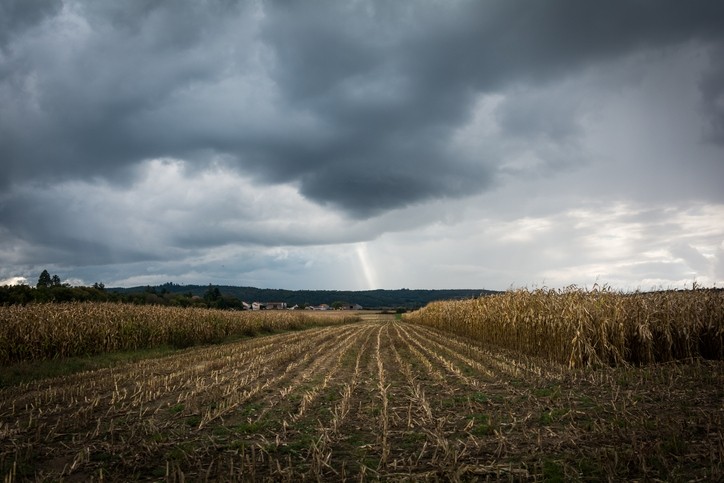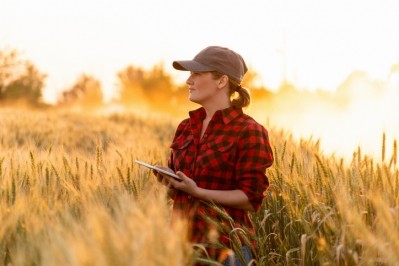USDA: Soy, corn crops see delayed harvest

The US Department of Agriculture (USDA) released details about crop production and condition in a report Monday [October 21].
Following a wet spring, which delayed, and warm September that provided a little more growing time to late-planted feed crops, in some Corn Belt states, cooler weather is anticipated, said Trent Ford, hydro-climatologist and Illinois state climatologist.
The 6 to 10-day forecast brings an “enhanced probability” of below normal temperatures for states ranging from the west coast to southeastern states like Kentucky, he told us. Parts of Illinois have started to see temperatures dip below freezing but hover above a ‘killing freeze.’
“As a low-pressure system tracks across the US, behind it will be an incursion of cold air from the north and that is what’s going to allow these cooler than normal temperatures,” he said. “The jet stream – that tends to bend and have a trough in it, and that allows the cold air to come through [from Canada].”
The shift is “not the best outlook” for late-planted feed crops working on reaching maturity, Ford said. “But it remains to see if temperatures will get down to the 28-degree Fahrenheit mark (-2.2 Celsius) – the killing freeze.”
“If we do get below the 28-degree mark, it won’t be an anomalously early freeze,” he said.
The challenge is that the corn crop planted in late May may still be looking for growing conditions typically found in mid-September, not mid-October, he added.
Producers with mature crops may see rain-related delays this week as well, he said. “It doesn’t look like a great week for productivity.”
Soybean development
The maturity of the 2019 soybean crop has started catching up with the pace of production set in earlier years, the USDA said. On average, about 97% of the crop is dropping leaves at this point and this year about 94% of the crop has reached that stage.
Only two states, Louisiana and North Dakota, have seen 100% of the crop reach that point, the department said. But, only four states reported that less than 90% of the crop was dropping leaves – Kentucky, Missouri, Ohio and Wisconsin.
The pace of harvest is further behind, the department said. On average about 64% of the crop has been collected at this time, while this year less than half the crop has been gathered. Of the 18 states responsible for the majority of US soybean production, nine have yet to see 50% of the crop collected.
Missouri and North Dakota have seen the slowest harvest, the department said. Kentucky, North Carolina and Tennessee are the only states to outperform the pace set both last year and on average.
On the condition side, this year’s soybean crop has not matched production in 2018, the USDA reported. Last year, at this point, about 66% of the crop earned a good or excellent condition score, while this year only 54% has.
Corn maturity
The late-planted corn crop continues to lag behind the production pace set in earlier years, the USDA reported. Last year, by this time, 99% of the crop had reached maturity and this year only 86% has hit that point.
Three of the 18 states planting corn acres have said that the entire crop is mature, the department said. Those include Kentucky, North Carolina and Tennessee.
Five states have yet to see three-quarters of the crop reach maturity, the department said. The three lagging farthest from completion are Michigan, North Dakota and Wisconsin.
Harvest pace has been slower than previous years, and only about 30% of the crop has been collected at this point, the USDA said. Previously, almost half the crop has been gathered by this time.
North Dakota, South Dakota and Wisconsin are experiencing the slowest harvest thus far, while Kentucky, North Carolina and Tennessee have completed the most, the department said.
Last year by this point in October, about 68% of the corn crop was considered good or excellent, the USDA said. This year, 56% of the crop has earned those scores.
Sorghum and wheat
Opposite to the trend set by corn and soy, sorghum maturity in the six states responsible for the majority of the crop has outpaced previous years, the USDA said. Last year at this stage about 88% of the crop had reached maturity and this year 92% has.
Texas is the furthers along with the entire crop having finished developing, while South Dakota is the slowest, the department said. Harvest pace for the current crop has landed between the timing set last year and average production.
Previously, about 45% of the crop was collected at this point in the year and on average, about 53% has been, the department said. Condition, however, is better this year than it was at this time last year.
In the states accountable for the majority of the spring wheat production, about 96%, has been collected the USDA said. Last year, and on average, the harvest was completed at this time.
However, winter wheat planting is progressing faster than it did last year, the department said. In 2018, about 71% of the crop was in the ground at this time and this year 77% has been planted.
The emergence of the winter wheat crop is in line with previous years, the department said. On average about 53% of the crop has sprouted by this point in the autumn, a pace repeated this year.
On a state-by-state basis, Nebraska and South Dakota have seen the most crop development with 85 and 80% of the planted acres spouting, respectively, while California, at 5%, and North Carolina, at 3%, have seen the least progress.












